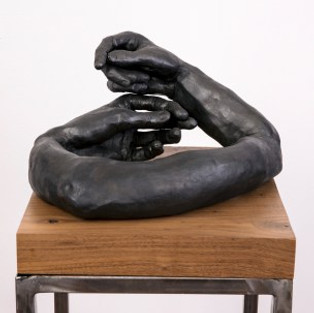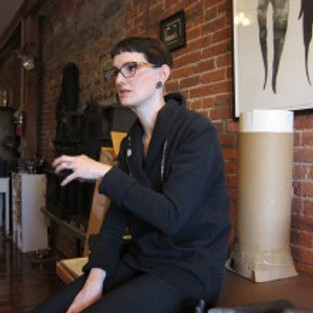Studio Visit: Camilla Taylor, Seeker of Shadows
- artandcakela
- Oct 18, 2017
- 6 min read

Camilla Taylor. Photo Credit Gary Brewer.
Studio Visit: Camilla Taylor, Seeker of Shadows
By Gary Brewer
“Actually, however, life begins less by reaching upward, than by turning upon itself. But what a marvelously insidious, subtle image of life a coiling vital principle would be! And how many dreams the leftward oriented shell, or one that did not conform to the rotation of its species, would inspire!”
Gaston Bachelard, The Poetics of Space
“We don’t know the contour of feeling, we only know what molds it from without.
Rainer Maria Rilke, Duino Elegies
“I have placed there a little door opening on to the mysterious. I have made stories.”
Odion Redon
The space in between ‘self’ and the body – interiority – a dark cipher communicating unease. They say that the eyes are the windows to the soul, if one passes through the eyes how do you portray what is inside? How does one depict the self inside out? Camilla Taylor’s work looks through a mirror darkly, searching for an expressive language to capture glimpses of this fleeting mirage we call self. She is fascinated with the disparity between self-perception and our deeds; how our self-deceptions give us comfort and smooth away the rough edges of our behavior that we deem irreconcilable with the identities we create. “People often say ‘I was not myself when I did that’ or ‘that was not the real me’ when caught behaving in ways they feel are unacceptable. We are our bodies, our actions and thoughts. We can create personal mythologies that make a better version of self, but often our acts do not align with these images we create”. Camilla seeks to disturb the mirage, to drop a stone into the reflective pool of Narcissus.’

Camilla Taylor. Photo Credit Gary Brewer.
Camilla uses the body, hands, hair, torsos and heads, creating powerful expressive forms and exploring materials and the impact that they have on the emotional tenor of her sculptures. It is a search for apparitions and visages that communicate something hidden, maybe something unwanted, to explore the secrets and lies of self embedded in the flesh. Camilla told me a story about one of her pieces. “Some time ago a Rapper/Artist saw one of my sculptures, “Dream Pursuers”, on Instagram and reposted it with the text, “Look at this creepy-ass-dope art”. Someone he knew made a comment about the sculptures, saying that as a child he had recurring nightmares in which he was being chased by creatures that looked like these armless dark apparitions. It was not the first time I had heard a similar response of familiarity. It was perhaps the most distant from me, a stranger to a stranger (a fan of the musician) having that reaction rather than another gallery attendee. It was a powerful revelation to me that I could create something that matched the image of a fearful memory, an image from someone’s subconscious. It was an affirmation that I was getting into the subjective space of ‘unease’ that I want to examine.”
Another group of sculptures, “They’ve already left,” conveys a strange animistic power. Standing about 5 feet high and originally in a grouping of six (there are now two left) they are quadrupeds whose headless apparitions add both a generality to ones interpretation of them and a Grimm’s Fairy-tale aura to the impression. Camilla wanted to add wounds to their bodies and thought to her self, “What kind of scars would form over their wounds”. She had been cutting up old shirts and dyeing them black to wrap the armature and create the forms. She had been saving the buttons (Camilla saves and recycles everything!) and it dawned on her that the scar tissue would be made of buttons. The effect is potent, the dark matte fabric bejeweled with shiny black buttons, the light reflected off of the buttons like hundreds of eyes glinting in the darkness.
Years ago a friend made a critical comment about her work, saying ‘you draw like a girl’. It was a comment that Camilla did not take entirely seriously, but she could not understand “what about my work looked like a ‘girls’”. She critically examined her work and decided to eliminate the eyes ‘the portals to the soul’, to focus on a form that conveyed the ‘shadow.’ She wanted to capture an image that represented the interiority of self, to bring the darkness into the light.
We spoke about her admiration for several artists; Kiki Smith, Louise Bourgeois and especially Magdalena Abakanowicz. As a student she saw an exhibition of Abakanowicz’s work. In the exhibit there was a room sized installation in which an immense form filled the space, it was titled “Head”. Something about the power of the work, its abstract immediacy, the emotional impact that the forms had on Camilla, and how it then shifted from pure abstraction into the ‘body’ – a fusion of expressive abstracted form transformed into speaking subjectively of the body, of pain and suffering – this work had a deep influence on Camilla’s future work. She also spoke of Giacometti’s insight into form being shaped by space and light, whittling away the form leaving only the vertical apparition. “The idea of subjective ‘space’ whittling away the edges of self, that the form has been shaped by subjective forces, leaving nothing but the shadow remains of its identity, this intrigued me. My works are almost all black. When one sees them from afar or out of the corner of ones eyes they flatten out becoming like a shadow on the wall.”
She told me about a piece of hers from her current exhibit at the Marie Baldwin Gallery titled “The Search”. It is ceramic with a graphite finish. It has two conjoined arms that cross in the front, the fingers animatedly picking at the air, the digits engaged in an activity. “I was frustrated by the interpretation people were giving to the piece. People called it “The Hug”; I don’t understand why people see a hug, especially in context with the rest of my work. It is actually a representation of a person picking at there own body eating themselves away in a piecemeal fashion. It is a metaphor about the idea of the insatiable appetite of the mind, that we must constantly devour ideas and images or we will go crazy.” It references several mythic images from the Buddhist idea of the ‘hungry ghost’ the insatiable appetite of the ego, and to Erysichthon of Thessaly who was cursed with insatiable hunger for cutting down a sacred forest in which he killed a Dryad Nymph. Unable to abate his hunger ultimately he was cursed to eat himself.
The darkness that is a part of the human condition is the shadow world that Camilla seeks to reveal. She spoke to me about a current work that she is creating, “I have several examples of stories about people who have created false narratives to gain redemption, love or belonging. These sources inform the work though they are not specifically about any one of them. In the “Poetics of Space” Gaston Bachelard spoke of dreams in which we discover a hidden room in our childhood home, a secretive space that allows us to create memories and to shelter them. I have painted two dollhouses black, I am filling them with dozens of small ceramic figures also painted black to convey this secretive interior space within which we create our private mythologies, the little ‘lies’ that make life more bearable.”
Camilla Taylor’s sculpture opens a portal into the interior world of self and the subconscious. They are courageous journeys into the midnight of the soul seeking the hidden mythologies that speak of human need, and desire. She wants to rupture the false narratives that we hide behind and pull from the dark, the mythic shadow puppets of the self, that are both unique and fabrications from the same pattern. Patterns from which the mythologies of the world are all woven from, spun from the same gossamer filaments dyed in the indigo darkness of the subconscious. These are the narratives that enable us to communicate and understand each other. It is these stories told in glimpses, the peripheral cognition of things just out of sight, or hidden in the shadows that Camilla seeks to bring to the light.
Exhibitions:
#losangeles #california #art #studiovisit #onlineartmagazine #materials #losangelesart #contemporaryart #process #southerncalifornia #LosAngelesArtists #artinterview #multimediaartist #artandcake #ArtandCakeLA #fineart #artist #garybrewer #arts #CamillaTaylor #artreview #sculpture #artmagazine #ArtandCulture #mixedmedia #visualart
































